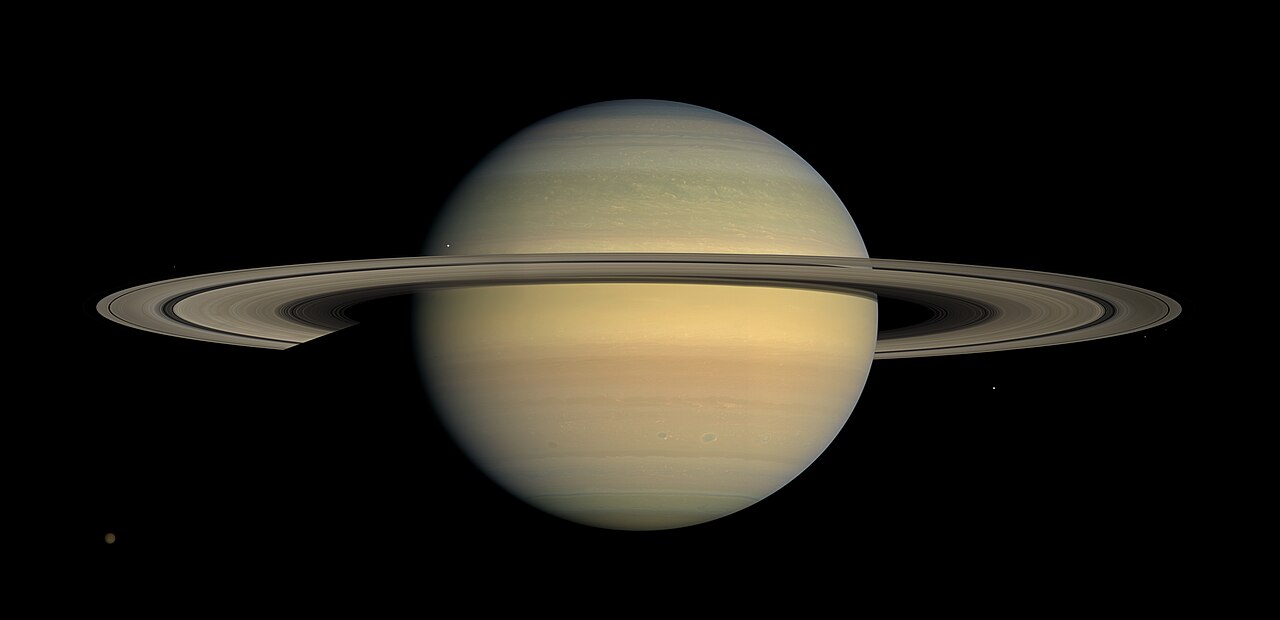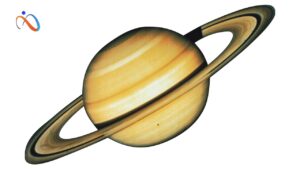Saturn is a very interesting planet to explore. The most intriguing quality is the presence of rings around it which makes it different from the other planets. These facts about Saturn will surely inspire you. Saturn is the second-largest planet in our solar system. Jupiter is the largest planet in the solar system, followed by Saturn. While every one of the gas goliaths in our nearby planet group has rings not a solitary one of them is essentially as broad or particular as Saturn’s.
Saturn is the only planet with a ring system. Saturn’s rings are made up of pieces of ice and rock, and they are unique in the solar system. The rings were discovered in 1610 by Galileo Galilei, and they are still being studied today to learn more about their history and composition.

From wikipedia.org – Photographed by Cassini in July 2008
Fun Facts About Saturn
Here are interesting fun Facts About Saturn That They Didn’t Teach you in science class:
All About Saturn Rings:
Saturn is renowned for its remarkable ring system, consisting of more than 30 rings. These rings are made up of countless icy particles, ranging from tiny grains to larger chunks. The composition of Saturn’s rings is quite unique. Lumps of ice, and rock, come from the moon and comets. These particles hang up in the air before they fall to the surface of the planet. We can see seven rings around the planet with each ring having two moons of the planet. These rings make sure that they control the movement of moons. Multiple satellites are also present which make the moons and rings apart from each other. It is the reason we can recognize them differently.
Atmosphere of Saturn:
Saturn’s climate is made out of 96% hydrogen and 4% helium. With the following measures of water, methane, and alkali, as per the European Space Agency. It has a range of 36,183 miles (58,232 kilometers), making it multiple times more extensive than Earth, as per NASA.
Composition of Saturn:
The planet has a thick center made of metals, for example, iron and nickel. Encompassed by rough material that is thusly wrapped by fluid metallic hydrogen subject to extraordinary temperatures and tensions.
The ongoing examination has recommended that Saturn’s center is certainly not a strong circle like the Earth’s, yet rather a smooth soup made out of rocks, ice, and metallic liquids sloshing around and influencing its gravitational force, which thus impacts the design of its enormous rings.
Impact on other Planets:
As the huge planet in the planetary group after Jupiter, the draw of Saturn’s gravity has helped shape the destiny of our nearby planetary group. It might have helped fiercely heave Neptune and Uranus outward. Alongside Jupiter, it could likewise have thrown a blast of garbage toward the inward planets right off the bat in the framework’s set of experiences.
Researchers are as yet finding out about how gas goliaths structure, and run models on early planetary group development to comprehend the job that Jupiter, Saturn, and different planets play in our nearby planetary group. A recent report recommends that Saturn, more so than Jupiter, steers perilous space rocks from Earth.
Estimation of the size of the Planet:
While the separation from the middle to the shafts is 54,000 km, the separation from the middle to the equator is 60,300 km. At the end of the day, areas on the equator are roughly 6,300 km more far off from the middle than the posts which is an incredible fact about Saturn.
We have a comparable peculiar fact here on Earth, where focuses on the equator are far off from the focal point of the Earth, however, on Saturn, it’s substantially more limited.
Spacecraft Visits:
Many spacecraft have visited the planet. It has been more than 40 years since Pioneer 11 reached Saturn. In 1979, scientists sent Pioneer 11 to the planet around the area of 20,000 km from its center. But none of the probes returned until June 18, 2017. Two years ago, NASA launched the Voyager-1 These successful visits are the reason why we have photos of the planet’s soil and its rings.
Tragically, there are no likely arrangements to send any more shuttles to explore the facts about Saturn.
Saturn Location in the Solar System:
Saturn is the sixth planet from the Sun and is situated between Jupiter and Uranus.
Distance from the Sun:
On average, Saturn is approximately 886 million miles away from the Sun. However, its distance can vary between 839 and 934 million miles due to its elliptical orbit.
Galileo’s Observation:
The first official observation of Saturn through a telescope was made by Galileo Galilei in July 1610. At the time, he mistakenly thought Saturn had a triple planet or Mickey Mouse-shaped head.
Diameter of Rings:
Saturn’s rings extend approximately 273,000 kilometers (170,000 miles) wide, but their thickness is only about 20 meters (66 feet).
Saturn’s Moons:
Saturn has over 80 known moons, with the largest one being Titan. Titan is even larger than the planets Mercury and Pluto.
Hexagonal Polar Vortex:
Saturn’s north pole features a distinctive hexagonal-shaped storm known as a polar vortex. This storm has fascinated scientists for years.
Intense Winds:
Saturn experiences incredibly strong winds that can reach speeds of up to 1,800 kilometers per hour (1,118 mph). These winds create distinct cloud bands and storms on the planet’s surface.
Golden Color:
Saturn’s beautiful golden color comes from the presence of ammonia crystals in its upper atmosphere. These crystals reflect sunlight, giving the planet its distinct hue.
Unique Seasons:
Similar to Earth, Saturn experiences seasons due to its rotational axis inclination. However, Saturn’s seasons are much longer, with each season lasting approximately seven Earth years.
Low Density:
Despite its enormous size, Saturn has a relatively low density. This means that if placed in a giant body of water, Saturn would actually float—a fascinating concept!
Saturn Rotation:
Saturn rotates on its axis quickly, completing one rotation in about 10h 33m, 36,840 km/h. (06-Feb-2020).
Rocky Core:
It is believed that at the center of Saturn, beneath its gaseous layers, there lies a rocky core composed of heavy elements.
Colorful Cloud Bands:
The planet’s atmosphere displays distinct cloud bands in various shades of yellow, gold, and brown due to the numerous chemical compounds present.
Ever-Changing Rings:
Saturn’s ring system is not permanent and constantly changes over time. The gravitational interactions with its moons and other celestial objects cause the rings to evolve and morph.
Continuous Research:
Scientists continue to study Saturn and its unique features to gain further insights into its formation, evolution, and the mysteries it holds.
These Fun facts about Saturn offer a glimpse into the incredible characteristics and scientific fascination surrounding our magnificent ringed neighbor in the solar system.

